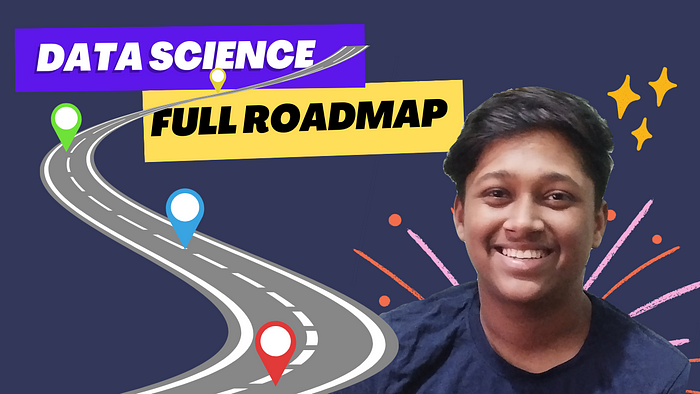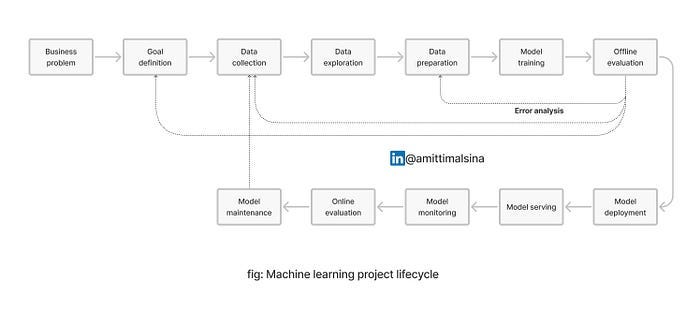How I became Machine Learning engineer at 18 years old | Full Roadmap for Beginners
At 18 years old, I landed my dream job as a Machine Learning Engineer, a role many consider highly competitive and reserved for professionals with years of experience. The journey was not easy. You can learn about my journey in this article series titled “My journey as a self-taught programmer.”

If you’re interested in becoming a Machine Learning Engineer but don’t know where to start, you’re in the right place. In this article, I will share the complete roadmap for becoming a Machine learning engineer 🚀. The roadmap is made from extensive research and discussions with multiple self-taught ML Engineers 👩🏽💻👨💻.
Whether you’re a beginner or have some experience, this guide will help you take the next step toward your career goals 🎓.
This article is adopted from my Machine-learning-engineering-roadmap repository in GitHub.
End to End machine learning 🤖

Machine learning is not just about building a model using some publicly available clean data. Multiple steps are required to build an ML product. Fig 1 shows the end-to-end steps required to build a machine learning product that could potentially make an impact 💥. I have a dedicated article series that goes into detail about each step shown in the above diagram.
I will divide the resources into different levels of learning and will also provide the best resources to learn each topic. The levels of learning are:
- Getting ready to learn data science 📊
- Core Data Science Fundamentals 📈
- Machine Learning Engineering 🤖
1. Getting ready to learn data science 📊
Applied Mathematics 🔢
Applied Mathematics is a combination of Linear Algebra, Statistics, Probability, and Calculus. There is a lot of buzz that you need to be great at mathematics for getting into Data Science 🤔. Unless you want to be a Machine Learning Researcher then the fundamentals of the above topics are sufficient. You will be just fine if you have a good grasp of high school mathematics. You can always go to grad school to be a Machine Learning researcher or start learning complicated mathematics after you land a job.
Nonetheless, below I mention some great resources on Coursera by the Imperial College of London for Linear Algebra and Calculus. Their videos are publicly available on YouTube 🎥. For statistics & Probability, I have some great recommendations for courses by MIT OpenCourseWare 🎓.
Linear Algebra: Mathematics for Machine Learning: Linear Algebra (Coursera), (YouTube)
Statistics: MIT 18.650 Statistics for Applications (YouTube)
Probability: MIT 6.041SC Probabilistic Systems Analysis and Applied Probability (YouTube)
Calculus: Mathematics for Machine Learning: Multivariate Calculus (Coursera), (YouTube)
Programming Language 💻
Deciding a Language:
Programming languages are essential tools for machine learning (ML) engineers, data scientists, and researchers to develop and deploy ML models 🚀. Machine learning requires programming languages that are capable of handling large datasets, performing complex computations, and integrating with powerful libraries and frameworks. The choice of programming language is critical for machine learning projects because it can affect development time, model performance, and scalability.
When it comes to choosing a programming language for machine learning, there are several criteria to consider:
- Learning curve: Ease with which a language can be learned,
- Community: A language with a large and active community means that there are more resources, tools, and support available online,
- Libraries and Frameworks: Existing libraries for every step of the machine learning project (shown in Fig 1),
- Industry demand: You should consider the industry demand for different languages,
- Performance: Performance is a critical factor to consider when working with large datasets.
Python and R are most popular languages for machine learning. Other programming languages are Julia, Java, and C++. Let’s see their comparison based on the criteria we discussed above:

If you want to be a software engineer with skills in machine learning, go with Python — you don’t even need to think twice. On the other hand, if you want to be a data scientist, you could choose either Python or R. But remember python will give you flexibility in your career if you ever want to pivot. On a personal note, I recommend python 🐍 to you.
🐍 Python for Beginners:
Programiz creates great resources for python developers of all levels. Their courses are a combination of video and text resources which have been praised by many.
🎥 Introduction to Python (Basic): https://www.youtube.com/playlist?list=PL98qAXLA6afuh50qD2MdAj3ofYjZR_Phn
Object oriented programming is very important for machine learning engineering. It will help you work with and understand frameworks like pytorch, transformers, many others. But no worries this 🎥 Object oriented programming (OOP) python course on YouTube has got you covered.
🔗 Below are additional resources just in case above are not up to your taste:
Note: Interviewers love to ask questions on Data Structures and Algorithms (mainly for roles other than interns). I have not mentioned resources for them here. But you can revisit them once after you complete all the steps mentioned here. Don’t stress it a lot at beginning.
Congrats, you completed the first step on your journey 🎉.
2. Core Data Science Fundamentals 📈
Data Collection & Exploration 🔍
Data collection and Data exploration are the core Data Science fundamentals as shown in the ML Lifecycle figure (Fig 2). Python libraries Numpy, Pandas, and Matplotlib will be your aid for core data science.
📗 Python for Data Analysis: Data Wrangling with pandas, NumPy, and Jupyter by Wes Mckiney will be more than sufficient. A Beginner shall start with this book as it covers basic Python, ipython, NumPy, Pandas, and Matplotlib followed by a few documented data analysis projects with code implementation.
I have seen many skip learning the core data science fundamentals for flashy Deep learning, which caused a lot of problems later when they started working on End-to-end machine learning to solve a business problem. So better learn soon than regret later.Additional resources:
- 🔗 Data Analysis with Python: Zero to Pandas
- 📗 Python Data Science Handbook (Chapter 1–4)
Tip: All the libraries mentioned above, have elegant documentation. Feel free to explore them as well.
SQL
Data Science is the all-around study of data. To work with data, we need to extract it from the database. This is where SQL comes into the picture. SQL is the most widely used programming language while working with databases and is supported by various relational database systems, like MySQL, SQL Server, and Oracle. A Data Scientist can control, define, manipulate, create, and query the database using SQL commands.
Many modern industries have equipped their products’ data management with NoSQL technology but, SQL remains the ideal choice for many business intelligence tools and in-office operations. This is why it has become a standard for many database systems. Modern big data systems like Hadoop, Spark also make use of SQL only for maintaining the relational database systems and processing structured data.
I have heard good things about 🔗 SQL Tutorial — Full Database Course for Beginners course available on YouTube.
Additional resources:
Notes:
1. Interviewers love to ask SQL questions for data science roles.
2. People usually have question around learning Big data tools in initial phases of data science, I personally think, it’s not necessary to learn big data tools in initial phases of data science, but if you’re interested in learning it, you can learn it later on. There are different perspectives on this, i would like you to check out the answers from this quora answer.
3. Machine Learning Engineering 🤖
Data Preparation/Feature Engineering
Most of the time, the raw data can’t be directly fed into a model. These raw data need to be prepared according to the model and task at hand. Data preparation is important regardless of whether the model is machine learning or deep learning. Feature engineering is needed for Machine learning while Deep learning is about learning those features through neurons.
Data preparation varies a lot based on the project and data. So, having good knowledge of python helps a lot. You will have to learn different libraries based on your requirement (your data preparation skills improve as you work on more projects). My suggestions for learning Data preparation and feature engineering are provided below:
- 🎥 Feature Engineering Krish Naik Playlist (YouTube)
- 📗 Approaching almost any Machine Learning problem (Chapter 6,7, 8) (Book available for free)
- 🔗 Data Preparation and Feature Engineering in ML (Article)
- 🔗 Advanced Feature Engineering Tutorial (Kaggle Course)
Machine Learning
For Machine Learning, I just have two suggestions for you.
- 🎥 Machine Learning Specialization 2022 — Andrew Ng, Stanford University -> This is the updated course and is perfect for 2023.
- 📗 Hands-On Machine Learning with Scikit-Learn and TensorFlow by Geron Aurelien (Part 1)
Deep Learning
MIT 6.S191: Introduction to Deep Learning is an ongoing course by MIT. You can find details on their website. This course has video lectures, code assignments, and great projects all of which will help you to have a good portfolio. None of my other suggestions will beat this if you sincerely complete the whole course.
- 📗 Hands-On Machine Learning with Scikit-Learn and TensorFlow by Geron Aurelien (Part 2)
- 🔗 DeepLearning.AI TensorFlow Developer Professional Certificate — Coursera
Deep Learning has different domains like reinforcement learning (RL), Natural Language Processing (NLP), and Computer Vision(CV). The above MIT course has good resources for RL and CV but it misses talking about NLP. Below are resources for it.
- 🎥 Natural Language Processing with Deep Learning (Stanford University)[NLP]
- 📗 Practical NLP from O’REILLY
Note: A lot of university courses for Machine Learning Engineering are public. You just need to search for them in youtube and go through their playlist.
MLOPs
MLOPs is a combination of Model Deployment, Model Serving, Model Monitoring, and Model Maintenance. I struggled a lot to learn about MLOPs because I couldn’t find good resources for it. I recently came across an MLOPs course that has everything required. I learned about all those topics separately but this course has everything in the same place.
Above course doesn’t have video tutorials. MLOPS course series by Krish Naik is a good start for beginners. But i still recommend the MadewithML course for all levels.
I will also recommend 📗 Practical MLOPs by Alfredo Deza and Noah Gift. It’s a great supplement to the course and provides practical knowledge that you can implement in your projects right away. 🚀
This article is just the beginning
Yes, you heard it. This is just the beginning of numerous resources that will help you get a job as a Data scientist or Machine learning Engineer. Stay tuned for resources on:
- Data science projects,
- Detailed Guide to Data Science Portfolio,
- Detailed Guide to Data Science Resume,
- Preparing for Job interviews, and many more.
I am open to suggestions from my readers. If you want me to improve some of the sections of this article, you can comment, email, or submit a pull request.
Stay tuned 😀 until next time.
